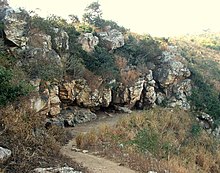This is an old revision of this page, as edited by Cyberbot II (talk | contribs) at 10:37, 18 February 2016 (Rescuing 1 sources, flagging 0 as dead, and archiving 0 sources. #IABot). The present address (URL) is a permanent link to this revision, which may differ significantly from the current revision.
Revision as of 10:37, 18 February 2016 by Cyberbot II (talk | contribs) (Rescuing 1 sources, flagging 0 as dead, and archiving 0 sources. #IABot)(diff) ← Previous revision | Latest revision (diff) | Newer revision → (diff)This article has multiple issues. Please help improve it or discuss these issues on the talk page. (Learn how and when to remove these messages)
|

| Part of a series on |
| Early Buddhism |
|---|
 |
| Buddhism |
Scriptures
|
| Early sangha |
| Pre-sectarian Buddhism |
Early Buddhist schools
|
| Terms |
The First Buddhist council was convened in the year following the Buddha's parinirvana (death), which is 543–542 BCE according to Theravada tradition, at various earlier dates according to certain Mahayana traditions, and various later dates according to certain Western estimates.
Dating the council
According to late commentarial accounts, King Ajātasattu sponsored the council. Tradition holds that on the full moon day of Shravan lunar month the Council was held in a hall erected by Ajātasattu outside Saptaparni Cave in Rajgir, three months after Gautama Buddha had died. Detailed accounts of the council can be found in the Khandhaka sections of the canonical Vinayas. Other sources state that the Buddha died 218 years before the coronation of Asoka in 269 BCE, so by this definition, the Buddha died in 483 BCE, which matches the reign of Ajātasattu.
According to this record, the incident which prompted Mahākassapa to call this meeting was his hearing a disparaging remark about the strict rule of life for monks. The monk Subhadda, who had ordained late in life, upon hearing that the Buddha had expired, voiced his resentment at having to abide by all the rules for monks laid down by the Buddha. Many monks lamented the passing of the Buddha and were deeply grieved but Subhadda spoke up to show happiness and relief that Buddha was gone.
And Subhadda, the late-received one, said to the Bhikkhus: "Enough, Sirs! Weep not, neither lament! We are well rid of the great Samana. We used to be annoyed by being told, 'This beseems you, this beseems you not.' But now we shall be able to do whatever we like; and what we do not like, that we shall not have to do."
Mahakassapa was alarmed by his remark and feared that the dhamma and Vinaya might be corrupted and not survive intact if other monks were to behave like Subhadda and interpret the Dhamma and the Vinaya rules as they pleased. To avoid this he decided that the Dhamma must be preserved and protected. To this end after gaining the Sangha's approval he called to council five hundred Arahants. Ananda was to be included in this provided he attained the state of the arahant by the time the council convened.

With the Mahākassapa presiding, the five hundred arahant monks met in council during Vassa. The first thing Mahākassapa did was to question the foremost expert on the Vinaya of the day, Upali, on particulars of the monastic rule. Mahākassapa asked him specifically about the ruling on the first parajika, with regard to the subject, the occasion, the individual introduced, the proclamation, the repetition of the proclamation, the offense and the case of non-offense. Upali gave knowledgeable and adequate answers and his remarks met with the unanimous approval of the presiding Sangha. Thus, the Vinaya was formally approved.
The Mahākassapa then turned his attention to Ananda in virtue of his reputable expertise in all matters connected with the Dhamma. The night before the Council was to meet, Ananda had attained Arahantship and joined the Council. Mahākassapa was able to question him at length about the Dhamma with specific reference to the Buddha's sermons. This interrogation on the Dhamma sought to verify the place where all the discourses were first preached and the person to whom they had been addressed.
Ananda aided by his word-perfect memory was able to answer accurately and so the Discourses met with the unanimous approval of the Sangha. The First Council also gave its official seal of approval for the closure of the chapter on the minor and lesser rules, and approval for their observance. It took the monks seven months to recite the whole of the Vinaya and the Dhamma and those monks sufficiently endowed with good memories retained all that had been recited. This historic first council came to be known as the Pancasatika because five hundred fully enlightened Arahants had taken part in it.
See also
References
- ^ The First Buddhist Council
- Gombrich, Richard (1988/2002). Theravada Buddhism. London: Routledge. Gombrich, p. 32, writes: "The Buddhist era begins at the Buddha's Enlightenment. Modern Theravadins date this in 544/3 BCE, but this tradition is of uncertain antiquity.... he best we can say is that he was probably Enlightened between 550 and 450 , more likely later rather than earlier."
- ^ Eleventh Khandhaka - On the Council of Ragagaha
- ^ The First Council
Bibliography
- Mukherjee, Biswadeb (1994). The Riddle of the First Buddhist Council - A Retrospection, Chung-Hwa Buddhist Journal, pp. 452–473
External links
- Mahisasaka account of the First Council
- BuddhaNet The First Rehearsal of Tipitaka
- The Illustrated History of Buddhism 54. The First Buddhist Council
- The Monist The First Buddhist Council, by Teitaro Suzuki